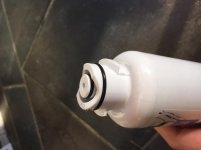mfisher
Hot Rolled
- Joined
- Oct 24, 2006
- Location
- Annapolis, Maryland
We had a GE refrigerator for years, that used the MWF style filter. That filter lasted for 4 to 6 months typically, unless there was road work or a pipe break (municipal water supply) that caused a slug of sediment to come through the pipes. In that case, it would plug quickly and need to be replaced.
After 20 years of that refrigerator (it was flawless, but being a counter depth it had limited room), we replaced it with a Samsung. This new Samsung uses DA29-00020B water filter. These have lasted about a month each. When new, they will put out over 32 ounces before the auto timer kicks out. I can track how bad they get when I fill a measuring cup to fill the tea kettle (that doesn't fit directly in the water dispenser cutout).
After going through several, and these filters aren't cheap, I finally went and installed a whole house 15 micron filter (large GE cartridge). And now here I am a few weeks later, the whole house filter is still mostly clean (water pressure in the house is fine), and I need to replace the refrigerator filter again. I do not want to just gut a filter and use it as a plug to get water through, but not filtered. The filters I have been using are real Samsung, not counterfeit. Really don't want to install another 'polishing' cartridge filter for just the refrigerator, but could if needed. Just not an easy place to do it.
Questions -
Years ago when I would camp, there were portable filters that could easily be backflushed, so I figure I could do the same. Any standard as to which is inlet and outlet on the filter? I am guessing inlet is center, and outlet outer ring. It would be easier if the normal inlet was the outer ring, so I could simply backflush through the center. Anyone know?
Is there a standard fitting of some sort for the filter mount, that I can buy and easily make a backflush device? I don't want to buy a replacement part from Samsung, but guess I could. The local dump frowns on pirating parts, especially from freon containing appliances.
There must be a market for an inexpensive backflush device. I can't be the only one with these problems. So if anyone wants, here is a business idea.
Thanks.

Inner diameter about 14mm, outer about 27mm, by a quick eyeball with a ruler.
After 20 years of that refrigerator (it was flawless, but being a counter depth it had limited room), we replaced it with a Samsung. This new Samsung uses DA29-00020B water filter. These have lasted about a month each. When new, they will put out over 32 ounces before the auto timer kicks out. I can track how bad they get when I fill a measuring cup to fill the tea kettle (that doesn't fit directly in the water dispenser cutout).
After going through several, and these filters aren't cheap, I finally went and installed a whole house 15 micron filter (large GE cartridge). And now here I am a few weeks later, the whole house filter is still mostly clean (water pressure in the house is fine), and I need to replace the refrigerator filter again. I do not want to just gut a filter and use it as a plug to get water through, but not filtered. The filters I have been using are real Samsung, not counterfeit. Really don't want to install another 'polishing' cartridge filter for just the refrigerator, but could if needed. Just not an easy place to do it.
Questions -
Years ago when I would camp, there were portable filters that could easily be backflushed, so I figure I could do the same. Any standard as to which is inlet and outlet on the filter? I am guessing inlet is center, and outlet outer ring. It would be easier if the normal inlet was the outer ring, so I could simply backflush through the center. Anyone know?
Is there a standard fitting of some sort for the filter mount, that I can buy and easily make a backflush device? I don't want to buy a replacement part from Samsung, but guess I could. The local dump frowns on pirating parts, especially from freon containing appliances.
There must be a market for an inexpensive backflush device. I can't be the only one with these problems. So if anyone wants, here is a business idea.
Thanks.


Inner diameter about 14mm, outer about 27mm, by a quick eyeball with a ruler.

